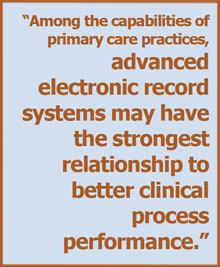Synopsis
A study of primary care practices in Massachusetts found a strong association between clinicians' frequent use of multifunctional electronic health records and higher practice performance on quality-of-care measures.
The Issue 
To improve the quality of health care, primary care practices are being encouraged to invest in tools and processes like physician performance feedback, automated reminders for patients, language interpreter services, expanded practice hours, and electronic health records. However, it is unclear whether these "structural capabilities," as they are sometimes known, will translate into higher-quality care. This study of more than 300 Massachusetts primary care practices examined the relationship between quality of care and practices’ structural capabilities.
Key Findings
- Based on responses to a series of survey questions, the prevalence of structural capabilities among the practices ranged from 25 percent(practice is regularly open to provide care on weekends) to 89 percent (physicians are aware of results on measures of clinical quality).
- Only 33 percent of practices reported frequent use of multifunctional electronic health records (EHRs); systems with more rudimentary functionalities were more common.
- Frequent use of multifunctional EHRs was associated with higher performance on three measures of screening (breast cancer, colorectal cancer, and chlamydia) and two measures of diabetes care (eye exams and nephropathy monitoring).
- Those practices whose staff met frequently to discuss quality scored higher on three measures of diabetes care (eye exams, cholesterol screenings, and nephropathy monitoring).
- In practices where physicians were aware of patient experience ratings, there was higher performance on both breast and cervical cancer screening measures.
- Other capabilities, including having a leader for clinical quality, were not associated with higher performance on any measure.
Addressing the Problem
Among the tools and processes investigated in this study, EHRs were strongly associated with higher-quality care, but only when the systems had advanced functionality encompassing lab and radiology results, specialist notes, medication lists, and electronic reminders. Such systems are uncommon at the national level. Increasing their adoption, say the authors, may help primary care practices improve performance in important areas of preventive care and chronic disease management.
About the Study
The authors surveyed Massachusetts primary care practices about their structural capabilities, including patient reminders, electronic health records, and access and availability issues, among others. They compared this information to performance data on 13 HEDIS (Healthcare Effectiveness Data and Information Set) process measures in four clinical areas: screening (breast cancer, cervical cancer, colorectal cancer, chlamydia), diabetes (hemoglobin A1c testing, eye examinations, cholesterol testing, nephropathy monitoring), depression (acute-phase contacts, acute-phase treatment, continuation-phase treatment), and avoidance of overuse (use of imaging studies for lower back pain, avoidance of antibiotic treatment in adults with acute bronchitis). The survey of 305 practices was conducted by mail from May 2007 to October 2007.
The Bottom Line
Advanced electronic health records may help to improve quality of care for primary care patients. The modest results of this study, however, highlight the importance of measuring the processes and outcomes of care delivered to patients.


